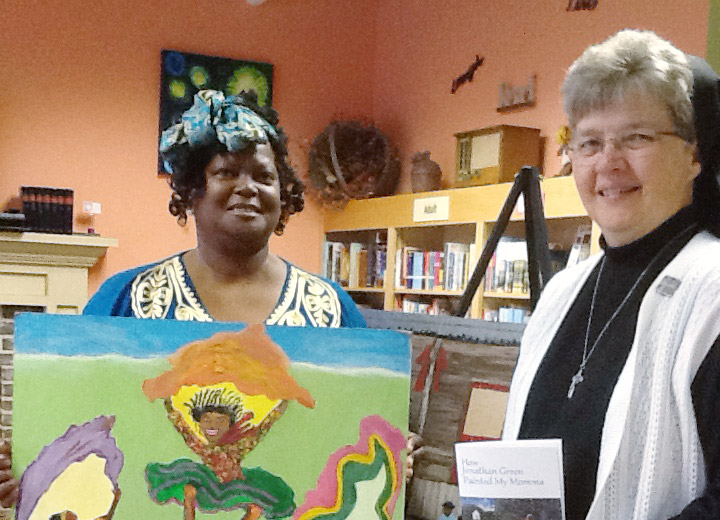
By Sister Pamela Smith, SSCM
Special to The Miscellany
For several consecutive Sundays, I’ve attended the Spanish Mass in our parish. I’ve also attended Mass in English with the five other sisters who are part of our local community, but I have some personal reasons for wanting, periodically, to sing from Flor y Canto and to respond “Y con tu espiritu” when the priest says, “The Lord be with you.”
One reason is simply to remember that the Church is catholic, with a small “c.” Another is to encounter once again a worshiping community in which language, culture and faith seem to be so smoothly blended, something which is not always apparent in Anglo environs.
A third reason is to witness evident zeal for the Gospel, which appears in vigorous preaching, spirited music — with piano, guitar, percussion, and saxophone — an expanse of multi-generational families stretched across pew after pew, and gestures of devotion like the praying of the man who kneels in the middle aisle before Mass with his arms extended cruciform. But the most profound reason for my wanting to participate in the Spanish Mass has to do with nostalgia and a reclaiming of roots.
From 1971 to 1972 I lived in Bethlehem, Pennsylvania, in a neighborhood that was rapidly becoming Puerto Rican. I was in one of those late 1960s early 1970s searches for self, soul, meaning, and a modicum of sense. The U.S. was in upheaval, and it was the heyday of flower children, wildly painted Volkswagen buses, and war protests. Anything that smacked of “the Establishment”— government, Church, educational systems, business, industry — seemed suspect.
To give a very abbreviated version of what happened that year, I would have to say that some key events propelled me into a major change of lifestyle: challenges from my Baptist and Mennonite friends led me to read Sacred Scripture deeply and extensively; an experience of Church at its best among the Puerto Rican people who attended Holy Infancy; the impact of living in an impoverished neighborhood where family meant more than achievement; a realization that helping the world become a better place was not so much about what to do but Who to follow. I realized that the one and only one who had the secret to transforming a planet which seemed bent on destruction was Jesus Christ.
Once that struck home, I experienced the revival of a sneaky feeling that I might be called to religious life. It was a calling that certain friends — those who had seen me through college, graduate school, four years of a teaching career, Friday nights at the Red Garter in Philadelphia, Saturday nights at the Main Point in Bryn Mawr, and wardrobes of kaftans, dashikis, tie-dyed T-shirts, and bell-bottoms — would find either laughable or unthinkable. The only ones who thought I might be a tad serious about convent life were the ones who had detected my undercurrents and outbursts of idealism.
In any case, attending Spanish Masses 44 years after I moved from South Bethlehem and 40 years since I professed vows also serves as a reminder of how I arrived at where I have been and where I am.
The Sisters of Saints Cyril and Methodius were a community I had encountered twice: once in grade school when we moved from New York to Pennsylvania, and then again one summer during graduate school at Villanova.
I was an educator, and I knew that they were too, but not in the mode of stuffy academics (part of the Establishment that I wanted to eschew). They were devout and companionable and down-to-earth. The SSCMs I met in both settings were good-hearted types with a notable sense of humor. Once I entered, I also learned that the sisters’ Slovak roots in many ways mirrored what I had treasured in my Puerto Rican neighborhood: an integration of faith and culture with everyday expressions that praised God in greetings, invoked God’s will when the future was discussed and mentioned God in farewells without shortening “God be with you” to “Goodbye.” There was poetry, art, music, and stitchery that bespoke both native land and native religion.
As I’ve lived with the sisters now for more than four decades, I’ve found that the community’s core mission has as much relevance and urgency as ever. We’re about prayer, community life, and service — what the Church calls sequela Christi, the following of Christ.
That has led us many places since our founding in the Diocese of Scranton. We’ve traversed 11 states, and had a brief stint in Slovakia after the collapse of Soviet Communism. We are in seven states to this day, serving in long-established institutional settings, start-up schools and missions.
The South Carolina six, among whom I serve now, have helped birth two new schools and have taken on an outreach center that touches the lives of the elderly poor, the resident Gullah population, and Spanish-speaking immigrants and migrant workers.
In many ways, our lives as women religious has replicated the more than 100-year history of our SSCM community and the history of sisters in the United States, and we’ve surprised ourselves with what we have done and where we have gone.
Faith, initiative, and resilience have marked our collective journey. In mysterious and mystifying ways, it has been all about a forceful line in the Lord’s Prayer that is our motto: Thy Kingdom Come!
Sometimes we learn that the Kingdom manifests itself and Christ appears in the midst of people who speak a language other than our own. Like attending Spanish Mass, it turns out to be a remarkable life lesson.
Photo provided: Rev. Gwendolyn Green (left) with Sister Pamela Smith, SSCM, at a Gullah art and book signing.
